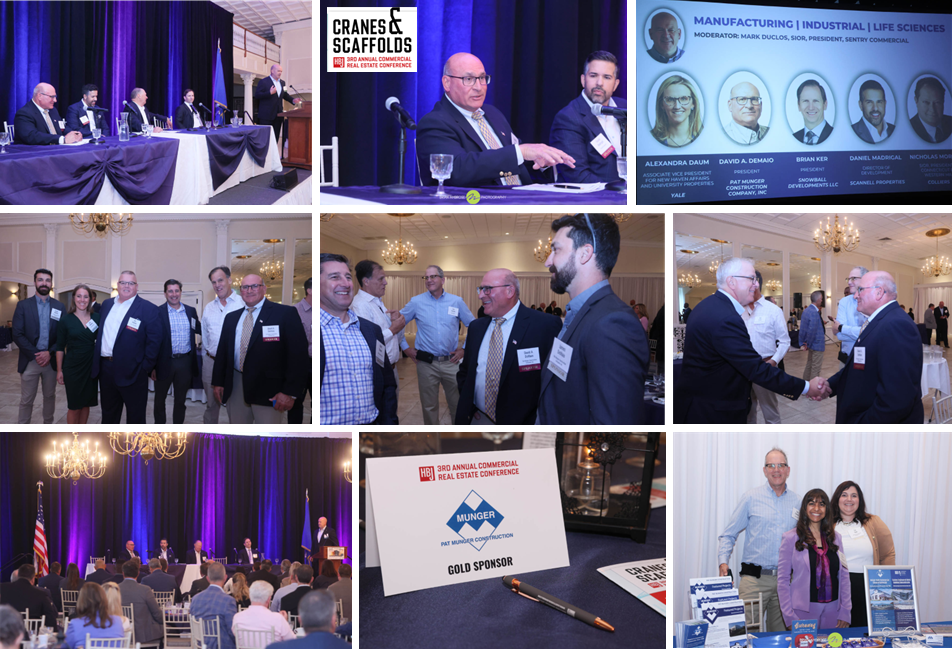David DeMaio, Featured Panel Speaker, at HBJ’s Cranes & Scaffolds Conference
Published on: Friday, September 12th, 2025

Connecticut has no problem attracting companies looking for warehouse space, but the state has significant challenges when it comes to building more of it, according to developers. “This is a great regional distribution hub,” said Brian Ker, president of Snowball Development, during Hartford Business Journal’s third annual Cranes & Scaffolds Commercial Real Estate Conference held Wednesday, September 4, 2025, at the Aqua Turf Club in the Plantsville section of Southington.
Ker spoke on a panel that discussed the state’s industrial real estate market. Other speakers included moderator Mark Duclos, president of Sentry Commercial; David A. DeMaio, President of Pat Munger Construction Company; Daniel Madrigal, director of development of Scannell Properties; and Nicholas Morizio, president of Connecticut and western Mass., of Colliers.
Ker said a lot of smart companies have already established large distribution footprints in the state, including Uline, a Wisconsin-based distributor of shipping, industrial and packaging materials that is building a 1.25 million-square-foot warehouse in Plainfield, and retail giant Amazon, which plans to open its 17th distribution center in the town of Plainfield this October. “… Other tenants are going to come a little late to the game and realize they probably should have showed up three years earlier,” Ker said.
He pointed to New York’s much higher industrial lease rates as a major reason why so many companies flock to Connecticut for space. He said leases in Westchester County, for example, are as high as $26 per square foot and require the tenant to also pay for property taxes, property insurance and maintenance. By comparison, Snowball, which has been one of the most prominent buyers of industrial buildings in the state, is charging as low as $7 per foot for some industrial properties it owns in Connecticut, he said. Ker said lower lease rates and Connecticut’s excellent location — with access to major highways and 23 million consumers within a 200-mile radius — should boost industrial real estate markets in Southington, Waterbury, Hartford and other towns and cities across the state. “How is Danbury not going to be a $15 market as tenants flee $25 rents?” he said.
Lots of hurdles
Still, there are many challenges impacting the industrial market, including a lack of available space.
“It’s just there’s nothing out there,” said Morizio, of Colliers. “Unless you’re willing to go into an older building that has a lot of problems, which none of them want to do, you’re going to have to pay more rent.” Ker said the Hartford region’s industrial property vacancy rate has fallen to around 4.5%, while developers are hesitant to build — and banks are reluctant to finance — construction of new facilities due to rising construction costs and other factors. There are little options currently available for tenants seeking over 100,000 square feet, Ker said, leading to higher rents.
The state’s high energy costs and cost of living pose additional challenges to the market, said DeMaio, of Pat Munger Construction. “That drives the cost of getting that widget out the door, and driving people either away from Connecticut or not coming in,” he said. “That’s a big deal.” DeMaio agreed with Ker on the state’s optimal location and lower lease rates, but he also pointed out that Connecticut has one of the most difficult permitting processes in the country, which acts as a major roadblock to new development. “New England, in general, is very, very difficult. It’s actually getting worse,” he said of the local permitting approval process. “We’ve spoken a lot at some of our association meetings about trying to get legislative bodies to look at zoning regulations on a regional basis, versus a town-by-town basis.”
He said a developer can spend 18 months getting all the necessary municipal approvals before putting a shovel in the ground. “That costs people a lot of money,” he said.
Madrigal, of Scannell Properties, said it never hurts to foster a positive rapport with planning and zoning officials when trying to get projects approved. “When we’re working with the tenant and we first meet with the town, some of them have literally rolled out the red carpet,” said Madrigal, whose firm is eyeing construction of two new warehouses in Windsor Locks. “They wanted the deal.”
The arrival of national commercial real-estate developers like Scannell into Connecticut’s market is helping to add more inventory, said Duclos, the panel’s moderator. “When I first got into this business 40 years ago, it was 100% a local market. Everything was smaller space,” Duclos said. “There were no national investors or developers in the marketplace.”
Source: Hartford Business Journal
- Category: Uncategorized